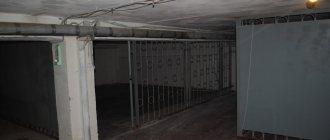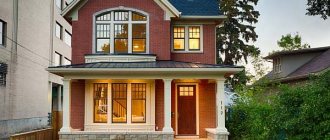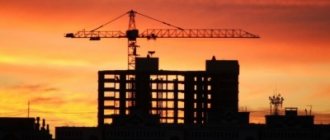Currently, the term “non-residential premises” is used quite often. Meanwhile, there is no clear definition of it in domestic legislation.
The gap in the standards leads to many difficulties for both ordinary citizens and entrepreneurs who want to transfer an apartment in an apartment building to non-residential premises. Due to the lack of a clear definition, illegal real estate transactions are often carried out in practice.
What is non-residential premises in an apartment building? Let's figure it out.
General information
Non-residential premises in an apartment building must be distinguished from common areas. The key feature is that the non-residential premises have a legal owner. Such objects are usually classified as commercial real estate. They are formed by converting an ordinary apartment in an apartment building into non-residential premises.
Owners of such objects are treated like apartment owners. Accordingly, they have the same rights and perform similar responsibilities as their neighbors. First of all, this concerns the costs of household services. The owner of non-residential premises in an apartment building must pay the same amount as other apartment owners. Moreover, the payment includes even those services that the subject does not actually use (for example, an elevator, a concierge).
Requirements for non-residential premises in an apartment building
At the legislative level, a number of rules have been established that owners of such objects must follow. These requirements are intended to ensure the protection of the interests of other apartment owners in a multi-apartment residential building with non-residential premises.
In such premises it is prohibited to carry out activities that cause environmental pollution or create an unfavorable sanitary and epidemiological situation. Simply put, in a non-residential building in an apartment building it is impossible to establish a public toilet or a medical facility for patients with infectious diseases.
The facility must comply with fire safety, sanitary and urban planning standards. The room must have a separate entrance. The object must be located on the ground floor or above other non-residential premises.
If the premises are equipped as a cafe or other catering establishment, it must close no later than 23.00.
Fire alarm for non-residential premises
Fire alarms in non-residential premises ensure the safety of the facility, the preservation of inventory, health and life of personnel located on the territory.
Non-residential buildings include office and shopping centers, warehouses, industrial and factory buildings, parking lots, airport buildings and many others. All of them place increased demands on security and alarm systems.
offers design and installation of security systems for non-residential premises of various types. You can also order maintenance, repair work, scheduled or unscheduled technical work from us.
List of non-residential premises where fire alarm installation is required
According to SP 5.13.130.2009, a number of premises are installed where the installation of fire alarm systems is and is not required.
Such systems are not installed in the following cases:
- for wet rooms (bathrooms, cooling chambers, showers, washing rooms);
- for exhaust and supply ventilation chambers
(except for premises belonging to categories A, B, boiler rooms, pumping stations); - for stairwells;
- for objects belonging to categories D, B4.
Installation of PS systems is required for the following premises:
- Shops, salons, shopping centers, exhibition complexes.
- For office premises.
- For workshops, industrial and other facilities.
- Public buildings, administrative centers, hotels.
Types of fire alarm systems for non-residential premises
To install a fire alarm for a non-residential premises, you need to choose the right type. Such systems are required for any places, commercial and industrial buildings, office centers with large crowds of people, which improves overall safety and detects the source of fire in time.
A very effective solution would be the integration of fire safety systems with video surveillance and other components, bringing management and control into a single center.
Fire alarms are divided into the following types:
- Threshold.
- Targeted survey.
- Addressable analog.
Also, the PS for non-residential premises includes a warning system and automatic fire extinguishing to ensure primary measures to combat fires.
Threshold PS
Threshold PS does not require special settings and can be installed in the shortest possible time. The system includes detectors with a threshold value and factory settings, and uses a radial-beam topology for operation.
The operating features of this type of substations make it possible to detect a fire and its source in time, but not to localize it with high accuracy.
Addressed survey PS
This is a more advanced alarm system with a receiving and control device that periodically sends signals to the sirens to determine the current status.
Signals of the following types are used for transmission: fire, normal, sensor malfunction, no connection. The advantages of a system of this type are the optimal quality-price ratio, control of fire detectors, and high information content.
Analog addressable
Today, this type of system is the best; the difference between an addressable analogue PS is that the situation is analyzed constantly. The decision to send a signal is made by the central control panel, based on the information it constantly receives from all sensors located at the facility.
Normative base
The legal status of non-residential premises in apartment buildings is regulated by various legal documents. The main one is the Constitution, which enshrines the right to private property.
Issues related to the operation of common property in apartment buildings are regulated by the Civil Code. Article 290, in particular, states that the owners of premises in apartment buildings have, by right of shared ownership, common premises, supporting structures, electrical, mechanical, sanitary and other equipment inside and outside their apartment, serving more than one premises. Legal owners cannot alienate their share of the right to such objects without transferring ownership of the residential premises.
The residential complex contains standards in accordance with which transfer to non-residential premises is carried out. In an apartment building, the reverse procedure is also possible.
A government decree of 2011 established the right of owners of non-residential premises to use the collective household reserves of the structure.
Regulatory regulation of issues relating to the objects under consideration is also carried out in accordance with acts of municipal and regional authorities.
Fire safety requirements for residential and office premises
Fire safety requirements for premises are a set of rules that regulate the rules for the use of various premises depending on their purpose.
Thanks to these requirements, the level of fire safety is significantly increased, which makes it possible to protect people from fire factors (smoke, fire, flames), eliminate injuries and deaths, and also minimize material damage that a fire can cause. Next, the relevant standards for different types of premises will be considered.
Fire safety requirements for premises
Depending on the functional purpose of the premises, fire safety requirements may differ. To do this, there are several types of premises, the requirements for which will be discussed below.
Living spaces
Fire safety requirements in residential premises provide for a set of procedures aimed at minimizing the likelihood of a fire and reducing the impact of its factors.
The need to comply with fire safety requirements at home
The implementation of these procedures begins at the building design stage, when a special audit of the fire hazard of the premises of the future building should be performed.
The maximum possible fire safety class of the facility must be determined and methods for suppressing the spread of fire and evacuating people must be thought out in detail.
A high level of fire safety in residential buildings should be ensured through the installation of highly effective warning systems. Their presence will eliminate fatalities in the event of a fire, minimize material damage and damage to material assets.
Room sizes
The area of the entire house includes the area of all apartments and the common area. The latter includes elevators, landings, basements, attics, etc. Their parameters are reflected in the technical passport, which is stored in the management company or in the HOA. Calculating the area is important when determining the amount of payment for utilities, in particular heating.
The size of non-residential premises is formed from the areas of all internal sections. Balconies and loggias are not taken into account. When determining their areas, reduction factors are used.
Fire safety of basements
- >
- >
- >
Published: 2014.01.22
The design and operation of basements require special attention: certain rules must be followed to avoid fire, which, in turn, can lead to significant material damage and threaten the health and life of service personnel. When operating basements, it is necessary to carefully observe, first of all, the requirements of the law: - Fire safety rules in the Russian Federation. — Set of rules SP 4.13130.2013. — internal regulatory documents of enterprises and institutions.
The most important measures to prevent fire hazards and other emergencies include the following:
- storage and use in basements is prohibited
Conditions for transferring a residential property to non-residential premises
Some owners do not use their apartments for their intended purpose, i.e. for living. Instead, they decide to convert the properties into non-residential ones in order to obtain a stable income.
The legislation establishes a number of conditions for such a transfer.
First of all, the room needs to be equipped with a separate entrance. If its area exceeds 100 m2, then there must be a second, emergency entrance.
A prerequisite is that there are no registered residents in the premises. Before transferring an object, you must check out of it.
There should be no encumbrances on the property. This means that the premises should not be pledged, mortgaged, or long-term leased.
As mentioned above, the apartment must be on the ground floor or located above other similar non-residential premises.
It is prohibited to convert residential premises into non-residential ones in emergency structures or buildings that must be demolished.
Another nuance - you can only transfer the entire apartment as a whole. You cannot make any one room in it non-residential.
Transfer may be refused if the structure is classified as a monument of cultural and historical heritage.
Exit from the premises in case of fire
During severe fires, it becomes clear how important it is to have escape routes in a building or vehicle. Additional escape routes are emergency exits. They help avoid numerous casualties and, under some conditions, save property.
Fire exit requirements
Routes and exits for evacuation in case of fire are thought out in advance when designing the building. If reconstruction, redevelopment, or change in the purpose of premises is planned, then appropriate amendments are made to the evacuation plan.
The width and number of fire exits is affected by:
- the number of people who must be evacuated along them at the same time;
- dimensions of the building, namely, the distance from rooms with people to exits;
- fire hazard class and purpose of the room.
According to building regulations dated July 21, 1997, the height of the fire entrance must be at least 1.9 meters. If there are less than 15 people in the room, then the width of the opening can be 0.8 meters. If there are more people, but not more than 50, then the width must be increased to at least 1.2 meters.
In preschool institutions and other buildings of category F 1.1, if they are intended for 10 or more people, at least 2 fire exits are provided.
If the room is separated by a fire partition, then a separate exit is made from it. The more convenient the conditions for exit, the safer and calmer the evacuation will be.
The path of travel is indicated by a sign depicting a person hurrying towards an open door or stairs. Such signs help to correctly navigate in an unfamiliar place.
Please note that the premises may include persons with limited mobility. Their movement should not be hampered by foreign objects; a convenient ramp will be built for disabled people.
An emergency exit differs from an evacuation exit in that it is used in emergency situations when other routes are blocked due to circumstances.
It is especially important to have an emergency exit in transport. It is organized through hatches and windows.
A hammer is placed next to the windows, which can be used to break the glass.
If the vehicle has doors that are controlled remotely from the driver’s (pilot’s) cabin, then an emergency exit is provided next to them.
Where does the exit lead?
An emergency exit from the first and ground floors, as well as from the basement, leads to the street. Escape routes run through corridors, foyers, and staircases, depending on the design features of the building.
Fire exits from higher floors lead first to lower ones.
In this case, the path can run through the corridor (foyer) to the staircase or type 3 staircase, which is located on the outside of the building.
This staircase is made of fire-resistant material, without cladding or cladding. The doors leading to it cannot be closed from the outside with a lock or bolt and blocked from the inside.
It happens that the escape route is laid through adjacent rooms. In this case, they should not belong to the category of high explosion and fire hazard (A, B).
Placing a fire exit in premises of class A and B is only possible if there is a technical room (utility room) for maintenance nearby, and there is no other way out of it.
During the fire training process, it is necessary to study the evacuation plan in order to clearly understand which direction to go.
An exit is not an emergency exit if there is a turnstile in it. There should be no sliding or lifting blinds, partitions, or gates in the openings.
They make movement difficult and can jam.
Evacuation routes are not organized along spiral staircases and staircases with winder or curved steps.
Signals and signs
If you hear the sounds of a fire alarm, smell smoke or other signs of fire, you must immediately leave the premises without panic. You can do this yourself, moving along the evacuation route to the fire exit.
Evacuation routes must be organized so that it is convenient and safe to pass through them without the use of additional fire-fighting equipment.
Features of the procedure
If all the conditions specified above are met, you need to collect a package of documents. It includes:
- Floor plan. It is issued by the BTI.
- Title document (certificate) for the apartment.
- Technical passport and floor plan.
- If redevelopment of non-residential premises in an apartment building is carried out, then its plan will also be provided. It must be approved by an authorized body that implements control functions in the construction industry. In this case, the consent of the residents of the house must be obtained for redevelopment.
- Statement. It is submitted to the relevant government agency. In Moscow, for example, it is the Property Department.
Documents, except for the application, can be submitted in the form of copies certified by a notary. The decision is made within 48 days (working days). The refusal can be challenged in court.
Nuances of exercising rights and fulfilling obligations
As mentioned above, the rights of owners of premises (residential and non-residential) in apartment buildings are identical. This provision also applies to public areas.
The responsibilities of the owners cover the area of utility payments. All owners must bear the costs of maintaining the common area, including those adjacent to the house. At the same time, the corresponding amounts will be accrued even if the owner of the non-residential premises does not use these territories.
As for rights, these include the right to vote at general meetings, as well as the opportunity to participate in the discussion and resolution of issues related to repairs, landscaping, choice of management method, etc.
What determine the requirements for a cafe?
Three main questions that may be of interest to future cafe owners are:
- where establishments can be located and what types of cafes there can be;
- what category of catering establishments should we include in order to better understand the requirements;
- what documents regulate the activities of the cafe.
Accommodation
The cafe can be located either in a separate building built for these purposes, or:
- in shopping centers;
- at train stations, ports, airports;
- modular buildings;
- in the basement of a house intended for housing;
- built-in and attached, as well as in attached-built-in structures in buildings for various purposes (industrial, administrative, sanitary and resort, medical).
Small coffee establishments with up to 50 jobs can be based in public residential buildings, train stations and shopping centers. In this case, the total area of the organization cannot exceed 700 square meters.
Owners of large cafes must build/rent separate buildings. If you are planning to open a cafe with more than 300 seats, you will need a special plan for its construction; such an establishment will have a citywide character. Their requirements should be considered separately.
Small and medium-sized cafes can be:
- general type with a number of seats from 50 to 200 people;
- and specialized ones with a slightly smaller number of places (from 25 to 100).
The latter include family-type cafes, bistro cafes, canteen cafes, tea cafes, coffee shops, ice cream parlors, children's establishments, self-service cafes and others. Cafeterias are very small establishments with the number of seats in the hall from 8 to 16. Cafe-bistros are not designed for seating. They are equipped with high tables without chairs.
Type of establishment
Cafes are establishments that sell ready-made meals. They also have the right to work with semi-finished products, if the cafe serves as a canteen, then with raw materials.
Based on the above, the SES and the Ministry of Emergency Situations formulate requirements for the cafe and its employees.
Main regulatory acts
- SNiP 2.08.02-89.
- SanPin 2.3.6.1079-01.
- SNiP 2.08.01-89 (for cafes, built-in type, located in houses).
- GOST 2874-82 No. 3143-84.
- MBT 5061-89 (raw material safety).
- GOST 30602-97/GOST R 50647-94.
- SNiP II-4-79.
- SanPiN 2.1.4.559-96.
Technological requirements are standardized according to SanPiN 42-123-4117 and SanPiN 42-123-5777. Environmental safety is determined by SanPiN 42-123-5777 and SNiP 2.08.02.
Fire safety measures are determined by GOSTs, SNiPs, laws, SP and other documents:
- Federal Law of the Russian Federation No. 123 dated July 22, 2008.
- GOST R 50762-2007.
- Federal Law of the Russian Federation No. 69 dated December 21, 1994.
- GOST 12.1.004-91
- SNiP 21-01-97.
- SP6.13130.2009.
- SP1.13130.2009.
- SP5.13130.2009.
- SP2.13130.2009.
- SP3.13130.2009.
- SP4.13130.2009.
- SNiP 11-4 (electrical safety).
Supply of utilities
Owners of non-residential premises in apartment buildings are given the opportunity to choose the most suitable option for them:
- Conclude agreements for the supply of services directly with service companies.
- Draw up an agreement with the management company or HOA.
The list of services that can be supplied to the user includes water, energy, heat, gas supply, and sewerage. However, they are provided in the same amount as to other apartment owners.
Owners of non-residential parts of the building are responsible for the proper maintenance of metering devices (meters). Their damage or failure must be promptly reported to the relevant suppliers src=»https://autogear.ru/misc/i/gallery/20380/2040857.jpg» class=»aligncenter» width=»690″ height=»460″ [/img]
Transfer of non-residential property to residential premises
To change the purpose of an object you must:
- Contact the design organization to create a redevelopment plan.
- Collect a set of documents. It includes a document of title, minutes of a meeting of residents, a project, a conclusion on the compliance of the object with the requirements established for residential premises, and a copy of the passport.
To transfer the premises, you must write an application and submit it with attached documents to the authorized authority. You will also have to wait 48 days for a response. If the transfer is refused, this decision can be appealed within three months.
If the answer is positive, it is necessary to carry out redevelopment and issue a new registration certificate. Then you should make changes to the real estate register and obtain a certificate of owner.
If the owner of the premises is a minor, all actions on his behalf are carried out by legal representatives. They can be parents, guardians, trustees, adoptive parents.










